The Nuclear Powered Merchant Vessel Market is estimated to be valued at USD 3.7 billion in 2025 and is projected to reach USD 5.7 billion by 2035, registering a compound annual growth rate (CAGR) of 4.5% over the forecast period.
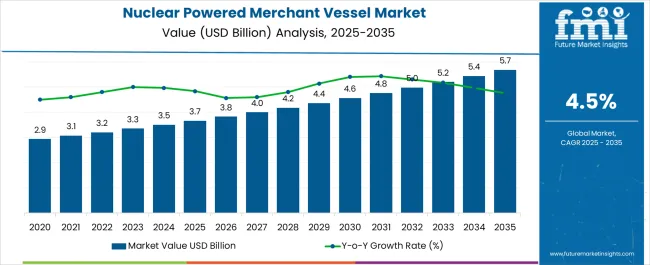
| Metric | Value |
|---|---|
| Nuclear Powered Merchant Vessel Market Estimated Value in (2025 E) | USD 3.7 billion |
| Nuclear Powered Merchant Vessel Market Forecast Value in (2035 F) | USD 5.7 billion |
| Forecast CAGR (2025 to 2035) | 4.5% |
The Nuclear Powered Merchant Vessel market is experiencing significant growth driven by the increasing need for sustainable and long-range maritime transportation solutions. The market outlook is shaped by advancements in nuclear propulsion technology, which offer higher efficiency, reduced carbon emissions, and extended operational range compared to conventional fuel-powered vessels. Rising environmental regulations and international maritime policies aimed at reducing greenhouse gas emissions are encouraging the adoption of nuclear-powered merchant vessels.
Investments in infrastructure and research for safe nuclear marine propulsion are also fueling market expansion. The demand for large cargo carriers capable of transporting massive volumes across long distances without frequent refueling supports the market growth.
Additionally, the adoption of nuclear-powered vessels is influenced by the need to optimize fuel costs and enhance operational efficiency in global trade and logistics As global trade volumes continue to rise and sustainability becomes a critical priority, nuclear-powered merchant vessels are poised to play a vital role in the future of maritime transportation, with continued growth expected in both developed and emerging regions.
The nuclear powered merchant vessel market is segmented by type, horsepower, size, load, and geographic regions. By type, nuclear powered merchant vessel market is divided into Cargo Carrier and Passenger Carrier. In terms of horsepower, nuclear powered merchant vessel market is classified into More Than 20,000 HP and Less Than 20,000 HP. Based on size, nuclear powered merchant vessel market is segmented into More 250 Mts (Nuclear Powered Merchant Vessel) and <250 Mts (Nuclear Powered Merchant Vessel). By load, nuclear powered merchant vessel market is segmented into More 50,000 Tons (Nuclear Powered Merchant Vessel) and <50,000 Tons (Nuclear Powered Merchant Vessel). Regionally, the nuclear powered merchant vessel industry is classified into North America, Latin America, Western Europe, Eastern Europe, Balkan & Baltic Countries, Russia & Belarus, Central Asia, East Asia, South Asia & Pacific, and the Middle East & Africa.
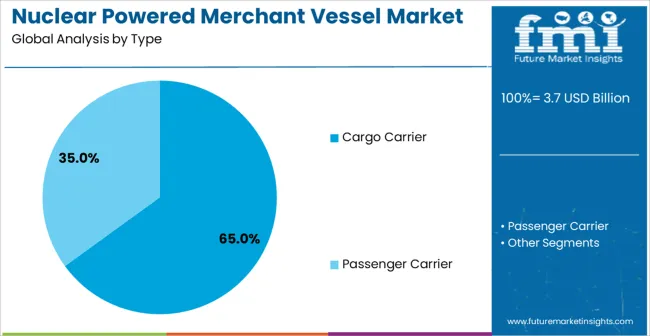
The cargo carrier type segment is projected to hold 65.0% of the Nuclear Powered Merchant Vessel market revenue share in 2025, establishing it as the leading type. This dominance is attributed to the high demand for transporting large volumes of goods over long distances efficiently. Cargo carriers benefit from nuclear propulsion by reducing refueling stops, lowering operational costs, and ensuring uninterrupted service on global shipping routes.
The ability to integrate advanced navigation and propulsion systems further enhances their operational reliability and safety. The growth of international trade and the need for sustainable and energy-efficient transportation solutions have strengthened the prominence of cargo carriers in this market.
Additionally, regulatory incentives and environmental mandates favoring low-emission vessels contribute to their widespread adoption The segment’s adaptability to different shipping routes and cargo types ensures its sustained leadership in the nuclear-powered merchant vessel market.
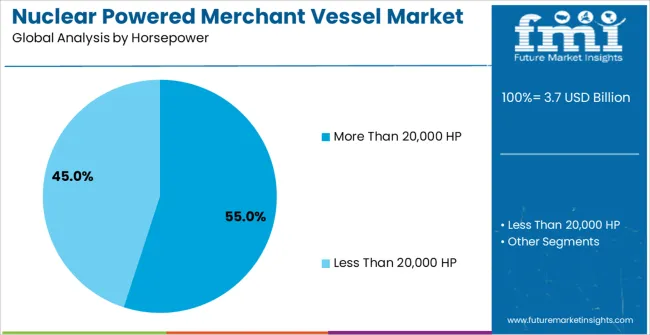
The more than 20,000 HP horsepower segment is expected to capture 55.0% of the market revenue share in 2025, making it the leading horsepower class. This growth is driven by the increasing requirement for high-powered vessels capable of transporting heavy loads efficiently over long distances.
Higher horsepower enables nuclear-powered vessels to maintain consistent speeds, navigate challenging maritime conditions, and optimize fuel consumption. The demand for operational efficiency, coupled with the ability to cover vast oceanic routes without refueling, reinforces the adoption of high-powered vessels.
Investments in advanced nuclear propulsion systems that deliver reliable and sustainable energy further support the segment’s growth As global maritime trade continues to expand, vessels with more than 20,000 HP are anticipated to remain a preferred choice for large-scale cargo transportation, ensuring operational excellence and compliance with environmental standards.

The more than 250 Mts size segment is projected to hold 60.0% of the market revenue share in 2025, establishing it as the leading size category. The growth of this segment is driven by the need for vessels that can accommodate high cargo volumes while ensuring efficiency and stability during long voyages.
Larger vessels benefit from nuclear propulsion by maximizing fuel efficiency, reducing operational costs, and enabling extended travel without frequent stops. The adoption of advanced design and engineering techniques enhances the safety, durability, and reliability of these large nuclear-powered merchant vessels.
The increasing scale of international trade and demand for energy-efficient, low-emission transport solutions have reinforced the prominence of vessels exceeding 250 Mts in length The combination of size, capacity, and nuclear propulsion makes this segment highly attractive for operators seeking to optimize logistics and sustainability in maritime transportation.
Nuclear energy has been used to drive a range of of carg ovessels including merchant, military and ice-breaker ships. A trading vessel or merchant vessel is a ship or boat that are used to transport passenger or cargo for hire.
Conventionally, merchant vessel/ships use diesel powered engine to burn the fuel and that drive the turbines. However, with the evaluation of technology the ships are now powered by nuclear reactor to drive the engines. Nuclear powered merchant vessel/ships uses central, internally constrained consumption & storage system instead of storing fluctuating and large quantities of fuels.
In 1950s, the world was introduced to an economical, thimble sized amount of nuclear material powering a vessel.
Most the countries have developed their individual nuclear powered merchant vessel. For instance, USA launched the NS Savannah – passenger cargo ship, Japan manufactured the Mutsu (which was decommissioned after a solo test run), Germany made the Otto Hahn (carried ore for nearly a decade) and Russia made the Sevmorput that carried cargo until 2025.
Henceforth, most the countries have their own nuclear powered merchant vessel to carry the passenger or cargo from place to other
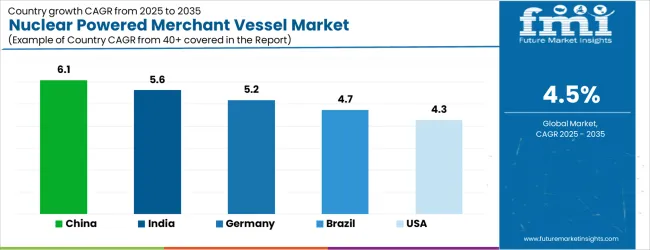
| Country | CAGR |
|---|---|
| China | 6.1% |
| India | 5.6% |
| Germany | 5.2% |
| Brazil | 4.7% |
| USA | 4.3% |
| UK | 3.8% |
| Japan | 3.4% |
The Nuclear Powered Merchant Vessel Market is expected to register a CAGR of 4.5% during the forecast period, exhibiting varied country level momentum. China leads with the highest CAGR of 6.1%, followed by India at 5.6%. Developed markets such as Germany, France, and the UK continue to expand steadily, while the USA is likely to grow at consistent rates. Japan posts the lowest CAGR at 3.4%, yet still underscores a broadly positive trajectory for the global Nuclear Powered Merchant Vessel Market. In 2024, Germany held a dominant revenue in the Western Europe market and is expected to grow with a CAGR of 5.2%. The USA Nuclear Powered Merchant Vessel Market is estimated to be valued at USD 1.3 billion in 2025 and is anticipated to reach a valuation of USD 1.3 billion by 2035. Sales are projected to rise at a CAGR of 0.0% over the forecast period between 2025 and 2035. While Japan and South Korea markets are estimated to be valued at USD 165.1 million and USD 93.3 million respectively in 2025.
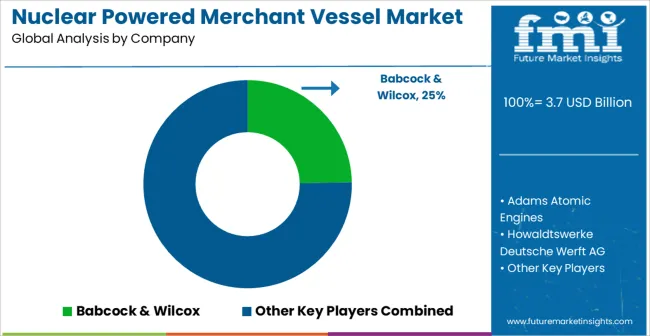
| Item | Value |
|---|---|
| Quantitative Units | USD 3.7 Billion |
| Type | Cargo Carrier and Passenger Carrier |
| Horsepower | More Than 20,000 HP and Less Than 20,000 HP |
| Size | More 250 Mts (Nuclear Powered Merchant Vessel) and <250 Mts (Nuclear Powered Merchant Vessel) |
| Load | More 50,000 Tons (Nuclear Powered Merchant Vessel) and <50,000 Tons (Nuclear Powered Merchant Vessel) |
| Regions Covered | North America, Europe, Asia-Pacific, Latin America, Middle East & Africa |
| Country Covered | United States, Canada, Germany, France, United Kingdom, China, Japan, India, Brazil, South Africa |
| Key Companies Profiled | Babcock & Wilcox, Adams Atomic Engines, Howaldtswerke Deutsche Werft AG, Yokosuka Naval Arsenal, United Shipbuilding Corporation (USC), and Austal |
The global nuclear powered merchant vessel market is estimated to be valued at USD 3.7 billion in 2025.
The market size for the nuclear powered merchant vessel market is projected to reach USD 5.7 billion by 2035.
The nuclear powered merchant vessel market is expected to grow at a 4.5% CAGR between 2025 and 2035.
The key product types in nuclear powered merchant vessel market are cargo carrier and passenger carrier.
In terms of horsepower, more than 20,000 hp segment to command 55.0% share in the nuclear powered merchant vessel market in 2025.






Our Research Products

The "Full Research Suite" delivers actionable market intel, deep dives on markets or technologies, so clients act faster, cut risk, and unlock growth.

The Leaderboard benchmarks and ranks top vendors, classifying them as Established Leaders, Leading Challengers, or Disruptors & Challengers.

Locates where complements amplify value and substitutes erode it, forecasting net impact by horizon

We deliver granular, decision-grade intel: market sizing, 5-year forecasts, pricing, adoption, usage, revenue, and operational KPIs—plus competitor tracking, regulation, and value chains—across 60 countries broadly.

Spot the shifts before they hit your P&L. We track inflection points, adoption curves, pricing moves, and ecosystem plays to show where demand is heading, why it is changing, and what to do next across high-growth markets and disruptive tech

Real-time reads of user behavior. We track shifting priorities, perceptions of today’s and next-gen services, and provider experience, then pace how fast tech moves from trial to adoption, blending buyer, consumer, and channel inputs with social signals (#WhySwitch, #UX).

Partner with our analyst team to build a custom report designed around your business priorities. From analysing market trends to assessing competitors or crafting bespoke datasets, we tailor insights to your needs.
Supplier Intelligence
Discovery & Profiling
Capacity & Footprint
Performance & Risk
Compliance & Governance
Commercial Readiness
Who Supplies Whom
Scorecards & Shortlists
Playbooks & Docs
Category Intelligence
Definition & Scope
Demand & Use Cases
Cost Drivers
Market Structure
Supply Chain Map
Trade & Policy
Operating Norms
Deliverables
Buyer Intelligence
Account Basics
Spend & Scope
Procurement Model
Vendor Requirements
Terms & Policies
Entry Strategy
Pain Points & Triggers
Outputs
Pricing Analysis
Benchmarks
Trends
Should-Cost
Indexation
Landed Cost
Commercial Terms
Deliverables
Brand Analysis
Positioning & Value Prop
Share & Presence
Customer Evidence
Go-to-Market
Digital & Reputation
Compliance & Trust
KPIs & Gaps
Outputs
Full Research Suite comprises of:
Market outlook & trends analysis
Interviews & case studies
Strategic recommendations
Vendor profiles & capabilities analysis
5-year forecasts
8 regions and 60+ country-level data splits
Market segment data splits
12 months of continuous data updates
DELIVERED AS:
PDF EXCEL ONLINE
Nuclear Medicine Shielded Equipment Market Size and Share Forecast Outlook 2025 to 2035
Nuclear Engineering Service Market Size and Share Forecast Outlook 2025 to 2035
Nuclear Energy Consulting Service Market Size and Share Forecast Outlook 2025 to 2035
Nuclear Robots Market Size and Share Forecast Outlook 2025 to 2035
Nuclear Imaging Devices Market Size and Share Forecast Outlook 2025 to 2035
Nuclear Medicine Equipment Market Size and Share Forecast Outlook 2025 to 2035
Global Nuclear Imaging Equipment Market Insights – Trends & Forecast 2024-2034
Nuclear Export Inhibitor Drugs Market
Antinuclear Antibody Test Market
Therapeutic Nuclear Medicine Market Analysis – Size, Share & Forecast 2024-2034
Filling and Dispensing System for Nuclear Medicine Market Size and Share Forecast Outlook 2025 to 2035
Plant life Extensions (PLEX) and Plant Life Management (PLIM) for Nuclear Reactors Market
Powered Surgical Staplers Market Size and Share Forecast Outlook 2025 to 2035
Powered Lawn Mowers Market Analysis - Size, Share & Forecast 2025 to 2035
Powered Storage Devices Market
Powered Screed Market
Unpowered Powder Classifiers Market Size and Share Forecast Outlook 2025 to 2035
AI-powered Wealth Management Solution Market Size and Share Forecast Outlook 2025 to 2035
AI Powered Software Testing Tool Market Size and Share Forecast Outlook 2025 to 2035
AI-powered Spinal Surgery Market Size and Share Forecast Outlook 2025 to 2035

Thank you!
You will receive an email from our Business Development Manager. Please be sure to check your SPAM/JUNK folder too.
Chat With
MaRIA